A Guide to Seasonal Produce - Spring Edition
A Guide to Seasonal Produce
Spring
Spring
 When you eat seasonal produce, you help reduce food waste,
support local farmers, reduce carbon emissions and save money. Seasonal produce
refers to fruits and vegetables grown in your local region during the current
season.
When you eat seasonal produce, you help reduce food waste,
support local farmers, reduce carbon emissions and save money. Seasonal produce
refers to fruits and vegetables grown in your local region during the current
season.
REDUCED FOOD WASTE
Food waste is a worldwide problem. It is estimated that
individually we waste over 209 lbs. of food each year.1 One
way to reduce
food waste is to purchase local seasonal produce. Fresh produce has a short
shelf life and needs to be eaten shortly after harvest. Most supermarkets and
local co-op purchase and resale local seasonal produce. The local farmer’s market
is another place to find seasonal produce and is a way to support your local
farmers.
REDUCED CARBON EMISSIONS
By purchasing seasonal foods, you are, hopefully, not
purchasing produce that traveled halfway around the globe to get to you.
Purchasing season foods reducing carbon emissions for this reason. By
purchasing seasonal fruits and vegetables, you are purchasing produce that
comes from the same region of the world as you and thereby, the produce had to
travel less distance to get to you.
SAVE MONEY
Seasonal produce costs less than its counterpart. There are
several factors that account for the reduced cost. One is the reduce amount of
fuel it takes to get seasonal produce to market because it is sold in the local
market. Secondly, as mentioned, fresh produce has a short shelf life and typically
seasonal produce is abundant. Therefore, the grower has an incentive to sell
for a competitive price, which results in lower prices for the consumers.
WHAT’S IN SEASON?
The USDA, through their SNAP-Ed
Program, has a list of seasonal produce divided by season. This list is a
general list for produce in season across the United States. If you want to be
more specific and look for produce in season by region, check out Seasonal
Fruits and Vegetables in Your Region.
Spring Seasonal Produce
Apples,
Apricots,
Asparagus,
Avocados,
Bananas,
Broccoli,
Cabbage,
Carrots,
Celery,
Collard Greens,
Garlic,
Kale,
Kiwifruit,
Lemons,
Lettuce,
Limes,
Mushrooms,
Onions,
Peas,
Pineapples,
Radishes,
Rhubarb,
Spinach,
Strawberries,
Swiss Chard,
Turnips,
CONCLUSION
If you want to eat healthy while supporting the environment then purchase and eat seasonal foods. By doing so, you will reduce carbon emission while supporting local farmers and your local community. Purchasing seasonal fruits and vegetables helps reduce food waste and provides you with fresh, healthy produce.
It’s good for you and the planet.
References:
USDA. n.d. Seasonal Produce Guide. SNAP-Ed Connection. https://snaped.fns.usda.gov/seasonal-produce-guide





Comments
Post a Comment